This morning when I open the curtains in my room, the view from the window is of the German town of Rudesheim. Two days ago it was Strasbourg in France, in a couple of days it will be the Dutch capital Amsterdam. I’m getting to see some of Europe’s most scenic spots yet I’m sleeping in the same bed every night. This is the beauty of river cruising.
In the past I’ve done coach tours and backpacked around Europe, but these days I’m over living out of a suitcase or rucksack, and I can’t handle the boredom of sitting in a coach or train for hours on end.
On a river cruise you unpack your suitcase at the beginning of the trip and don’t get it out again until the end. A lot of travel is done at night, so there’s no having to watch mile after mile of sometimes uninspiring scenery flash by. The voyage is carefully planned so when there is something scenic to see, you can sit on deck with a cold drink and enjoy the view as you float past. I could get used to this.
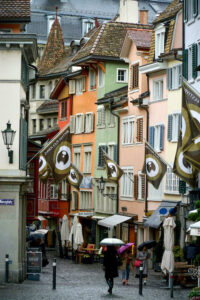 My husband and I are doing a week-long Rhine cruise. The official starting point is Zurich in Switzerland, although the Rhine doesn’t go anywhere near Zurich – the boat actually leaves from Basel, an hour-long drive away. After a day in picturesque Zurich, with its pretty pastel-coloured buildings and lake, set in front of snow-capped mountains, we’re taken by coach to Basel, an industrial city which is home to several major drug companies. The port where we’re dropped off is not exactly a picture postcard location but we’re too busy checking out our boat to pay much attention.
My husband and I are doing a week-long Rhine cruise. The official starting point is Zurich in Switzerland, although the Rhine doesn’t go anywhere near Zurich – the boat actually leaves from Basel, an hour-long drive away. After a day in picturesque Zurich, with its pretty pastel-coloured buildings and lake, set in front of snow-capped mountains, we’re taken by coach to Basel, an industrial city which is home to several major drug companies. The port where we’re dropped off is not exactly a picture postcard location but we’re too busy checking out our boat to pay much attention.
Only a couple of months old, the pristine boat feels like a boutique hotel, small but elegant. Unlike ocean cruise ships, which can carry a couple of thousand passengers, this boat has room for just 138 of us.
There’s one dining room, a large lounge with bar and dance floor, and a small lounge stocked with books and games like Scrabble. There’s no room for a swimming pool, just a spa pool, and the fitness centre is actually a small room with a treadmill and some other exercise contraption.
But it does have a hair salon, a couple of computers in the lobby with internet access, and plenty of sun loungers on the upstairs deck.
Our cabin is tastefully decorated with a flat screen TV, mini-fridge and floor-to-ceiling windows that slide open (thoughtfully, horizontal metal bars have been installed to stop you falling overboard).
The boat is so quiet I don’t even notice we’ve set sail. When we wake up the following morning we’re in Strasbourg and so begins a week of non-stop sightseeing. The price of the cruise includes guided excursions in all the places we visit. The tours are led by local guides who wear radio mikes tuned into headsets with tiny earpieces handed out to passengers. These ingenious devices mean you don’t have to crowd around your guide like a flock of sheep – you can stand several metres away and still hear what’s being said.
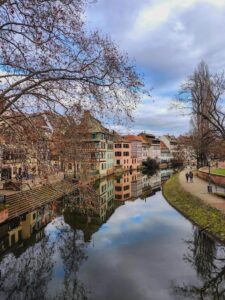 We try out the headsets for the first time after boarding a small boat for a trip along the River Ill, which surrounds central Strasbourg. The city is probably best known as the home of the European Parliament, and we get to see the spectacular modern building where this organisation is housed. But the entire island on which the city centre sits has also been classified by Unesco as a world heritage site for good reason – it is full of gorgeous old buildings, from the stunning gothic Strasbourg Cathedral to the charming mediaeval district, Petite France. Here, narrow cobbled streets and a series of canals wind their way through half-timbered buildings with geranium-filled balconies. It is all lovely but one of the most beautiful sights is the Ponts Couverts, three 13th century towers connected by wooden footbridges across the river.
We try out the headsets for the first time after boarding a small boat for a trip along the River Ill, which surrounds central Strasbourg. The city is probably best known as the home of the European Parliament, and we get to see the spectacular modern building where this organisation is housed. But the entire island on which the city centre sits has also been classified by Unesco as a world heritage site for good reason – it is full of gorgeous old buildings, from the stunning gothic Strasbourg Cathedral to the charming mediaeval district, Petite France. Here, narrow cobbled streets and a series of canals wind their way through half-timbered buildings with geranium-filled balconies. It is all lovely but one of the most beautiful sights is the Ponts Couverts, three 13th century towers connected by wooden footbridges across the river.
We get more time in the afternoon to check out Petite France on our own and we walk so my feet feel bruised. But this city is so enchanting it is worth it and I write myself a mental note: come back to Strasbourg one day.
I promise myself the same thing about Heidelberg the next day. It’s an hour-long coach ride from where we are docked on the Rhine and we head straight for the city’s main attraction, the schloss, or castle. Left in ruins by wars, fires and two lightning strikes, the original parts date back to 1214 while other sections were added on over the centuries. Today, not a lot is left standing, but those parts that do remain are striking, including the ornate red sandstone Renaissance façade with nothing but open air behind it, and the moat which is carpeted in a luxurious-looking cloak of green vines. It’s all very romantic.
The old town of Heidelberg spreads out underneath the castle down to the River Neckar and after touring some of the quaint lanes and squares, and then visiting the Church of the Holy Spirit with our guide, we have some time to do our own thing. We head for the unimaginatively named but very photogenic Old Bridge with its stand-out towers, the tops of which look uncannily like the pointy helmets German soldiers used to wear up until World War I.
The day after Heidelberg we’re in Mainz, where we call in at the Gutenberg Museum to learn all about the city’s most famous son, Johannes Gutenberg, who invented the printing press back in 1452. Then, after a look inside Mainz’s magnificent Romanesque church, it’s back to the boat for a short journey to our next destination, Rüdesheim. This is what you imagine a typical town on the banks of the Rhine to be like – all cobbled lanes and pretty houses with steep gabled roofs and shuttered windows. I half expect to see men in lederhosen gulping out of steins filled with foamy lager. Actually, make that glasses of riesling – we’re in wine country now.
 Our tour here is to an interesting museum of mechanical musical instruments and then after strolling down the famous Drosselgasse, a narrow pedestrian street crammed with bars, restaurants and souvenir shops, my husband and I take the cable car up over vineyards to the impressive Niederwald Monument. The 10m bronze statue of Germania looks down over Rüdesheim and the Rhine, and the expansive view is well worth the trip up.
Our tour here is to an interesting museum of mechanical musical instruments and then after strolling down the famous Drosselgasse, a narrow pedestrian street crammed with bars, restaurants and souvenir shops, my husband and I take the cable car up over vineyards to the impressive Niederwald Monument. The 10m bronze statue of Germania looks down over Rüdesheim and the Rhine, and the expansive view is well worth the trip up.
The next day is the highlight of the cruise. We are sailing through the Rhine gorge so everyone sits on deck, listening to our cruise director’s informative commentary and admiring the magnificent scenery. Unlike the beginning of the trip, where the banks of the Rhine were lined with factories, warehouses and silos, this 65km stretch of the river looks like something straight out of a fairytale. One dramatic castle after another is perched on cliffs high above the water, looking down on dense swathes of forest or rows of vines crisscrossing the steep slopes like a gigantic patchwork quilt. By the water’s edge are towns made up of higgledy-piggledy clusters of ancient buildings. My jaw keeps dropping and my camera is working overtime.
One notable sight is the Lorelei Rock where, according to legend, a beautiful maiden lured men to their death on this treacherous part of the river with her mesmerising singing.
By lunchtime we’re in Koblenz, another lovely riverside town with more than its fair share of centuries-old buildings, despite the fact it was heavily bombed in World War II.
I have to admit I’m feeling “churched-out” on this trip, so the next morning my husband and I decide to skip the organised tour in Cologne, which starts at the renowned Cologne Cathedral.
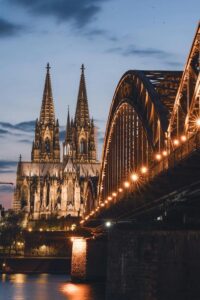 But we can’t help ourselves – when we later head off on our own, we end up at the cathedral and are glad we’ve made the effort. From the mosaic floors of the nave to the gold shrine, vivid stained glass windows and soaring ceilings, it is quite simply breathtaking. Work on the Catholic church started in 1248 and took more than 600 years to complete but the workmen obviously did a good job – it was hit 14 times by bombs during World War II but didn’t collapse.
But we can’t help ourselves – when we later head off on our own, we end up at the cathedral and are glad we’ve made the effort. From the mosaic floors of the nave to the gold shrine, vivid stained glass windows and soaring ceilings, it is quite simply breathtaking. Work on the Catholic church started in 1248 and took more than 600 years to complete but the workmen obviously did a good job – it was hit 14 times by bombs during World War II but didn’t collapse.
While the massive church with its twin spires dominates the city, there is more to Cologne than the cathedral. With the limited time we have we manage to do some shopping (including buying a bottle of the famous 4711 Eau de Cologne, even though I don’t actually like the stuff) and enjoy a beer or three in a character-filled riverside pub.
From there we head to our last destination, Amsterdam. The final excursion is a boat tour around the canals that help make Amsterdam so special and then we have the rest of the day to look around on our own. After the order and cleanliness of Germany and Switzerland, Amsterdam feels chaotic and upbeat yet laidback. Arriving here is like changing out of your spotless Sunday best into your comfortable but trendy jeans.
There’s no time to see even a fraction of what Amsterdam has to offer so we content ourselves with meandering alongside the tree-lined canals and over some of the 1200 bridges in the city, admiring the narrow crooked houses and popping into boutiques, small art galleries and curio shops. It’s late afternoon when we find ourselves in the infamous Red Light District. We tuck our cameras out of sight as the working girls are known for hurling tourists’ cameras (sometimes with the tourist still holding it) into the canals if they think they’re being photographed.
Finally, it’s back to the Affinity for our last night on board before flying out of Amsterdam the next morning.
We’ve packed a lot into a short amount of time and we’ve done it in style and comfort.
Oh yes, I really could get quite used to this.
Article by Donna Fleming






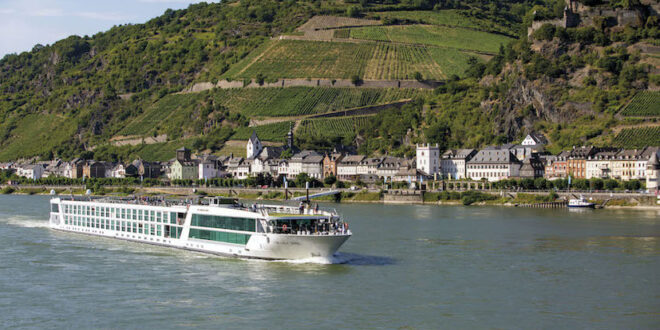
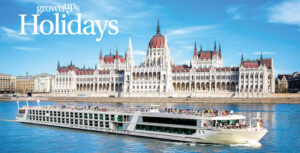

Join the Discussion
Type out your comment here:
You must be logged in to post a comment.